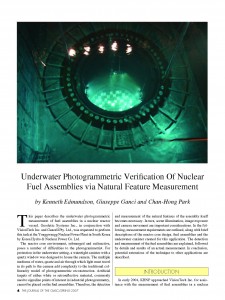
|
Download Members: $0.00 Non‑Members: $75.00 |
Buy Now |
Publication Details
| Published Date: | |
|---|---|
| Authors: | Kenneth Edmundson, Giuseppe Ganci, Chan-Hong Park |
| Company: | CMSC |
| Print Format: | Technical Paper |
| Citation: | Kenneth Edmundson, Giuseppe Ganci, Chan-Hong Park, "Underwater Photogrammetric Verification of Nuclear Fuel Assemblies via Natural Feature Measurement," The Journal of the CMSC, Vol. 2, No. 1, Spring 2007 |
Abstract
This article describes the underwater photogrammetric measurement of fuel assemblies in a nuclear reactor vessel. Geodetic Systems Inc., in conjunction with VisionTech Inc. and Gancell Pty. Ltd., was requested to perform this task at the Yonggwangg Nuclear Power Plant in South Korea by Korea Hydro & Nuclear Power Co. Ltd. The reactor core environment, submerged and radioactive, poses a number of difficulties to the photogrammetrist. For protection in the underwater setting, a watertight canister with a quartz window was designed to house the camera. The multiple mediums of water, quartz, and air through which light must travel in its path to the camera add complexity to the traditional collinearity model of photogrammetric reconstruction. Artificial targets of either white or retroreflective material, commonly used to signalize points of interest in industrial photogrammetry, cannot be placed on the fuel assemblies. Therefore, the detection and measurement of the natural features of the assembly itself becomes necessary. In turn, scene illumination, image exposure and camera movement are important considerations. In the following, measurement, requirements are outlined, along with brief descriptions of the reactor core design, fuel assemblies and the underwater canister created for this application. The detection and measurement of the fuel assemblies are explained, followed by details and results of an actual measurement. In conclusion, potential extensions of the technique to other applications are described.






